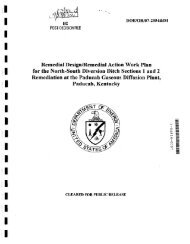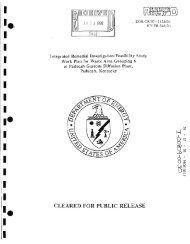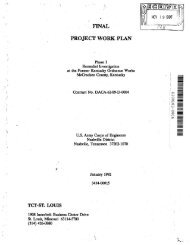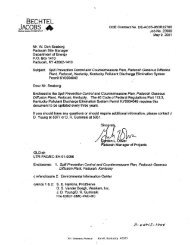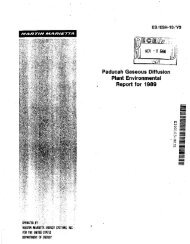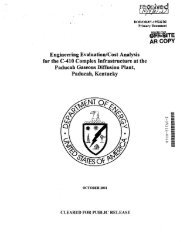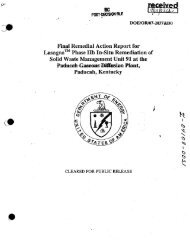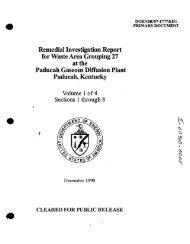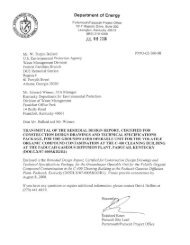1 - paducah environmental information center
1 - paducah environmental information center
1 - paducah environmental information center
Create successful ePaper yourself
Turn your PDF publications into a flip-book with our unique Google optimized e-Paper software.
Annual Site Environmental Report for 1999<br />
Radiolog'ical Environmental<br />
Su,rve,i 111'ance<br />
Abstract<br />
The radiological <strong>environmental</strong> surveillance program assesses the effects of DOE activities on the surrounding<br />
population and environment. Surveillance includes analyses of surface water, groundwater (Section 9),<br />
sediment, te"estrial wildlife, and direct radiation. Surveillance results indicate that radionuclide concentrations<br />
in sampled media were within applicable standards in 1999.<br />
I ntrod uction<br />
The radiological <strong>environmental</strong> surveillance<br />
program at the Paducah Site is based on DOE<br />
Orders 5400.1, General Environmental<br />
Protection Program, and 5400.5, Radiation<br />
Protection of the Public and the Environment,<br />
which require that an <strong>environmental</strong> surveillance<br />
program be established at all DOE sites to<br />
monitor the effects, if any, of DOE activities on<br />
the surrounding population and environment.<br />
Surveillance includes analyses of surface water,<br />
groundwater (Section 9); sediment, terrestrial<br />
wildlife, and direct radiation.<br />
Ambient Air<br />
Per the 1993 DOEf(:JSEC transition, USEC<br />
is responsible for the existing radionuclide<br />
airborne point-source discharges at PGDP, with<br />
the exception of DOE's Northwest Plume<br />
Groundwater System. DOE has fugitive<br />
emission sources including piles of contaminated<br />
scrap metal, roads, and concrete rubble piles.<br />
DOE utilized ambient air monitoring data to<br />
verify insignificant levels of radionuclides in<br />
off-site ambient air. Ambient air data is collected<br />
at eight sites surrounding the plant in order to<br />
measure radionuclides emitted from Paducah<br />
Site sources including fugitive emissions. The<br />
RadiationlEnvironmental Monitoring Section of<br />
the Radiation Health and Toxic Agents Branch<br />
of the Department for Public Health of the<br />
Kentucky Cabinet for Health Services conducted<br />
the ambient air monitoring during 1999 (KCHS).<br />
Based on observations for 1999, airborne<br />
radionuclides emitted from the Paducah Site,<br />
including the,PGDP, were not detected by the<br />
ambient. air monitors.<br />
Meteorological Monitoring<br />
DOE Order 5400.1 requires that DOE<br />
facilities collect representative meteorological<br />
data in support of <strong>environmental</strong> monitoring<br />
Radiological Environmental Surveillance<br />
5-1



